This post may contain affiliate links. If you click on one and purchase something, I may receive an affiliate commission — at no extra cost to you.
Over the past few years, Colombia has become quite a trendy destination for many. While Cartagena has long been a cruise ship port of call, the rest of the country had long been only on the path of more adventurous travelers. If you’re considering booking a flight, here’s a first-timer’s itinerary for 10 days in Colombia (not counting flying days).

Like many other countries in South America, Colombia is incredibly diverse, and there’s no way you’ll get to explore all its fascinating aspects in one short trip.
This Colombia itinerary is just a taste of the country by way of three major cities: Bogota in the Andes, Medellin in the Aburra Valley, and Cartagena on its Caribbean coast.
Table of Contents
Is Colombia safe?
This is probably either a question on your mind or a question others will ask you when you say you’re going to Colombia, so let’s just get it out of the way first.
Safety in Colombia is relative and dependent on where in the country you are. There are certainly still places in the country where you shouldn’t go, particularly in border and frontier regions, but most of the larger cities are relatively safe these days.
Here’s my evaluation based on personal experience:
- Bogota, no less safe than other major capitals like San Jose, Costa Rica or Kathmandu, Nepal
- Medellin, no less safe than other big cities like Shanghai, China or Milan, Italy
- Cartagena, no less safe than other touristy cities like Barcelona, Spain or Phuket, Thailand
In other words, exercise normal traveling caution.
Keep an eye on your surroundings and your belongings, know before you go, stay in well-lit areas that have other people, and trust your gut.
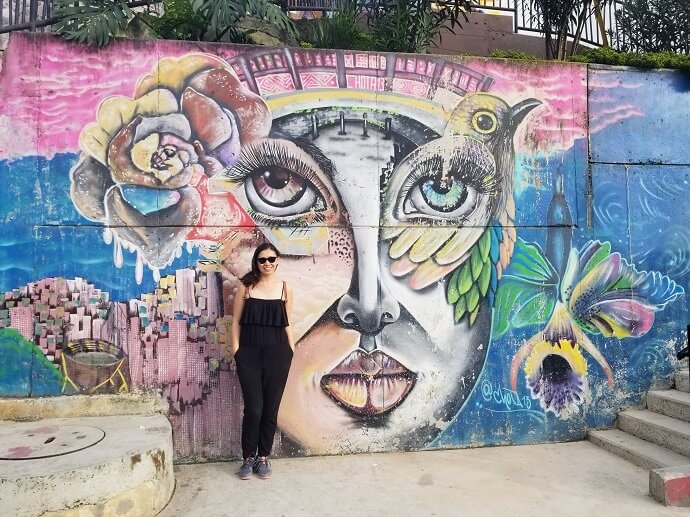
Honestly, the only reason I ever felt even a little uncomfortable while in Colombia was because neither my partner nor I spoke more than basic Duolingo Spanish. Had we been able to communicate more fluently, the trip probably would’ve been better because we would have had fewer hiccups and been able to chat more with the locals.
What to expect in Colombia
A few quick tidbits that will make your visit go smoother:
Language: There are English speakers in touristy areas, but otherwise it’s pretty limited, so equip yourself with Google Translate or another translation app and learn some Spanish ahead of time.
I had been able to understand most interactions in Cuba with only a little bit of difficulty (and without the aid of Google Translate since my cellphone didn’t work there).
But the Spanish spoken in Colombia was much faster. I was constantly asking people “Uno mas por favor, tu habla un poco rapido para mi.” (I know, I know, that’s not the right construction, but I had a hard time remember “una vez mas.” “Uno mas,” on the other hand, is always handy for ordering another round.)
Weather: Colombia’s geographical diversity means the weather can be incredibly different from one place to the next. For this Colombia itinerary, you’ll move from dry and cold mountainous temperatures in Bogota to warm valley weather in Medellin to tropical humid heat in Cartagena.
When we visited in late April and early May,
- Bogota ranged from high-40s to mid-60s Fahrenheit
- Medellin had mid-60s to mid-80s
- Cartagena went from low-80s to low-90s — but with enough humidity for it to feel like 105 at 8 a.m.
In other words, pack diversely and appropriately. Check out my packing list for this trip — carry-on only!
Toilets: Except in super nice places, you usually need to put toilet paper in the trash can provided instead of down the toilet.
Be nice to the plumbing.
Money: Colombian bills are big! Get to know your money and how they convert to your home currency, and don’t get bamboozled by others or your own confusion. (Guilty!)
In 2019, $1 USD is equivalent to approximately $3,200 Colombian Pesos (COP). And yes, they use the dollar/peso sign as their currency symbol.
The thing about drugs: You may know a thing or two about Colombia’s dark history with cocaine and the infamous drug lord Pablo Escobar. While Colombians don’t deny this history, keep in mind that Colombians were the people who suffered the most under Escobar’s reign. Your best bet is to avoid ever saying his name out loud, and while you’re at it, skip the word “cocaine” as well.
Okay, let’s get started with this itinerary 10 days in Colombia. Recommendations for where to stay and how to get around will be included under each city.
And as a quick reminder, this itinerary assumes that you’ll have 10 days in Colombia plus two travel days bookending it.
Days 1-2: Dive into Bogota
Bogota is a huge city. Seriously, as inhabitants of a 7-miles-by-7-miles city, Bogota felt intensely large.
After your arrival the previous day, make sure to take some time to absorb your surroundings and get acclimated. Not only will you be in a new country, you may also need to adjust to Bogota’s elevation: a whopping 8,660 feet (similar to many ski resorts).
One of my favorite ways to get adjusted to a new city is just to walk around, eat street food, and get a sense of how people interact with each other.
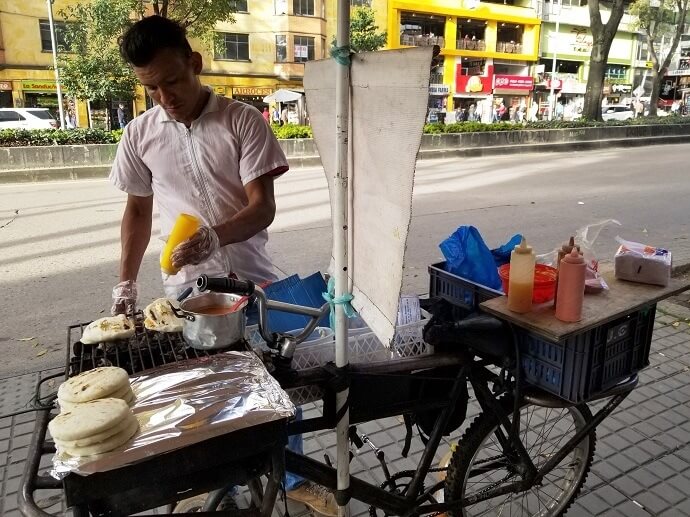
Learn about Bogota’s history
To get acquainted with the city, start your first morning in Bogota with a free walking tour with Beyond Colombia.
I’m usually not a huge fan of large tours, but I knew very little about Colombia other than its status as a former Spanish colony. And in such situations, I’ve found that free walking tours can be a great way to learn about the city and see many of its main sights in a contextualized fashion.
Our guide Bryon, a historian by education, did a fantastic job introducing us to the history of Colombia and Bogota, provided the cultural context behind the city’s street art, and gave us a sense of what else we could do during our time in Bogota.
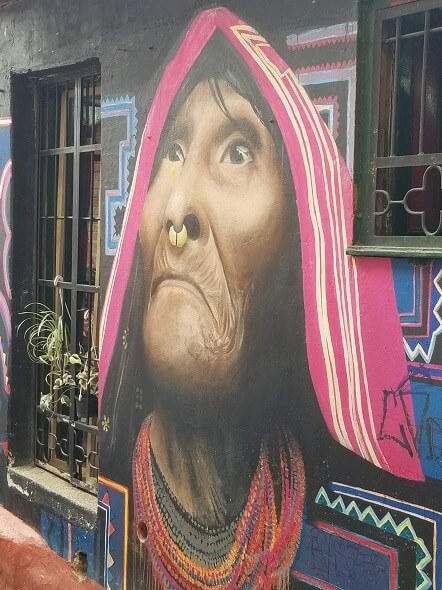
Participate in Colombia’s national sport
Then it’s time to experience something 100% Colombian.
We wanted to do something local that was off the tourist path but very much in Bogota, and tejo provided us with that opportunity.
Check out this post about the national sport of tejo. Hint: there’s gunpowder and beer involved!
Summit Monserrate
Head out early on your second day in Bogota and hit the sacred hill that towers over Bogota. You’ll see many locals hiking up and down Monserrate either as a pilgrimage to the church and shrine at the top or simply as exercise.
The religious aspects weren’t that interesting to us, but the hike was really nice and the views of the city were stunning.
Just make sure to drink plenty of water and take it slow. Bogota is already pretty high up, and the top of Monserrate sits at 10,341 feet.
You can also take the funicular or cable car up and down if you’d prefer.
Have some hot chocolate with cheese
Yep, you read that right. Colombian hot chocolate has a surprise ingredient you have probably never associated with the drink: cheese. Sweet and salty all in one.
Sounds weird, I know, but unless you’re lactose intolerant or don’t like chocolate, you just have to give it a try. Plus, it makes for a nice snack after your Monserrate hike.
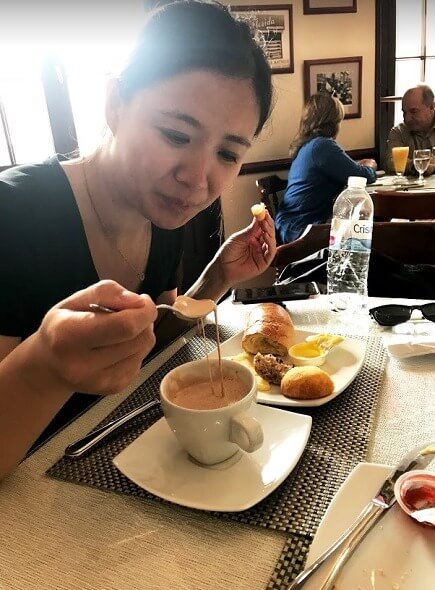
Explore the Museum of Gold
Once you’ve cooled down, check out the world’s largest gold collection.
While all the gold is nice and shiny, the real treasure is in the collection’s preservation of the country’s pre-Columbian heritage.
If you can, try to go on Tuesdays, Fridays, and Saturdays at 11 a.m. or 4 p.m. when they have guided tours in English. I’m told those make it much more informative and easier to take in the museum’s 55,000+ pieces of gold.
The information is helpful especially because the museum can be a little repetitive and out of context if you don’t know a lot about Colombia’s pre-Columbian heritage. The museum has exhibit halls for each of the country’s indigenous cultures, but the artifacts can look rather similar once you get to the 5th or 6th hall if you’re like me and unfamiliar with the differences.
If you’re unable to make it to those guided tours, make sure to at least check out the main exhibits, including the famous Muisca Raft, aka the El Dorado Raft.

Where to stay in Bogota
The bulk of Bogota’s main sights is in La Candelaria, one of the city’s 20 districts. It’s not known as the safest neighborhood, but it’s certainly the most convenient if you want to be close to everything. Many hostel options are also there, and if I had been traveling solo, I probably would have stayed in La Candelaria.
Near it is Chapinero, the hipster, trendy, LGBTQ-friendly neighborhood that’s popular with ex-pats and tourists.
You can also stay in Teusaquillo like we did, but we’d recommend you stay in the part of Teusaquillo that’s closer to La Candelaria unlike at the far end like we did. It often took 40-50 minutes to get into town center where everything was!
How to get around Bogota
Real talk: getting around Bogota can be a little difficult if you’re not staying in the central neighborhoods and are a little deficient in Spanish. (Also doesn’t help if you’re wandering the city after a sleepless redeye.)
If you find yourself not staying in one of the aforementioned central locales where you can just walk, you’ll have the option of :
- Taxis. These are fairly cheap in Bogota, even when you’re going long distances. If you’re not staying at a well-known hotel, make sure you’re able to tell or show the driver the cross streets for your destination.
- TransMilenio, the bus system that has dedicated lanes. You’ll need to buy a Tu Llave card and add credit to it to board these buses. (At certain stops, there are loaner cards where you can pay in cash and use the card to board, but it’s not guaranteed.)
- SITP buses, the good old regular buses that share the Tu Llave card with the TransMilenio buses.
- Busetas/colectivos, or unofficial mini-buses that you can flag down. They have signs in their windows indicating the major streets they pass. You pay cheaper cash fares on these. It’s mostly locals who take these, so let’s just say when two non-Spanish speaking gringos (aka yours truly) somehow flagged down the right colectivo on their first try, the locals were quite amused.
Days 3-4: Medellin, once the world’s most dangerous city
Unlike many recent travelers to Colombia, I did not associate Medellin with the drug trade that ravaged the city and its residents for decades. I’ve also never seen more than a few minutes of Narcos, the Netflix-show that has rather split Colombians’ opinions of its portrayals.
Instead, I knew Medellin as a popular South American spot for digital nomads, a place of temperate weather and delightful street art.
Hear Medellin’s history
So for me, it made sense to start our time in Medellin with a free walking tour to learn more about the city’s history. Make sure to book your spot with Real City Tours ahead of time; the booking window opens 1.5 days before your preferred tour time.
One of the most fascinating things I learned was about how the city has used social urbanism to rejuvenate the city. That is, going into the previously more dangerous areas of the city and using architecture to create something good.
For example, creating a forest of Colombia bamboo and light pillars in Plaza Cisneros, a place that used to be full of drugs and prostitutes, or building big beautiful libraries in tough neighborhoods that had no safe common spaces.
A concept we could probably apply in many cities around the world!



Taste Colombian craft beer and aguardiente
Then check out some Medellin institutions for lunch and an afternoon drink to escape the heat.
For a traditional paisa lunch in the downtown area, try Hato Viejo or Hacienda and get your fill of the famous local dish of bandeja paisa. This heavy plate of meat, beans, and carbs will fuel you up, so consider splitting a platter if you’re not really hungry.
If you’re adventurous, I’d suggest trying mondongo at the restaurant of the same name. This tripe, veggie, and corn soup is topped with rice, avocado, and even a banana. It’s not everyone’s bowl of flavor, but I loved it.
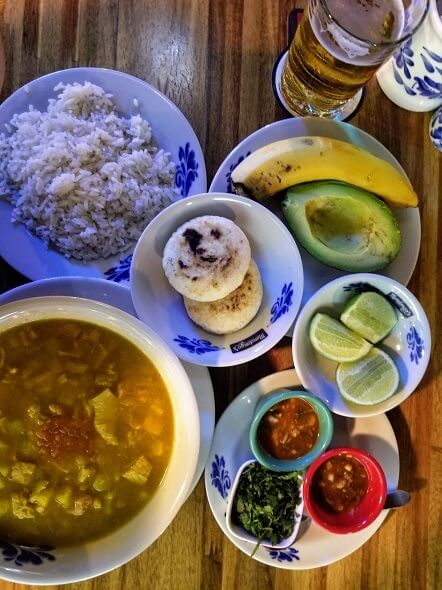
If your traditional lunch induces a food coma and the walking tour made your legs tired, spend a lazy afternoon at Salon Malaga, which has been a Medellin institution for more than half a century.
It is old-school in the most charming ways, a place where you feel so comfortable just passing the afternoon away with beers and new friends. (Less chill when rounds of aguardiente come around, but you should try this Colombian liquor nonetheless.)
Visit the infamous Comuna 13
I know, I know, you’re asking yourself why I have yet another free walking tour in this Colombia itinerary.
I won’t lie, it surprises me, too. We probably did more walking tours in Colombia than I usually do in a year’s worth of travels. But you’ll definitely want to join a tour for Comuna 13.
Medellin was once known as the world’s most dangerous city, and Comuna 13 was its most dangerous neighborhood.
Today, the neighborhood is slowly improving itself economically, and it is no more dangerous than anywhere else in the city. In fact, because of the extra policing, locals feel it’s actually safer than other areas of the city.



What really necessitates a tour guide is the personal stories they can offer.
If you go with Zippy Tour, your guide will be someone who grew up (and often still lives) in Comuna 13. The personal experiences they can share is something you’ll never get simply by visiting on your own (maybe unless you spoke fluent Spanish and spent enough time there to gain the trust of the residents).
Where to stay in Medellin
It’s tried and true: the expat neighborhood of El Poblado was truly a fantastic place to stay in Medellin. The neighborhood was very walkable, you could easily get to other areas of the city via public transit, there are a lot of dining and nightlife options, and overall it was just a gorgeous neighborhood.
We really enjoyed staying at 574 Hotel.
It’s small boutique spot nestled in a quiet area of El Poblado but also close to the metro and the main thoroughfares of the neighborhood. Clean, quiet, and chic at approximately $50 USD per night for two people, breakfast included. Would highly recommend!
How to get around Medellin
Compared to Bogota, Medellin is easy peasy when it comes to public transit.
It’s got the country’s only metro system, and that’s about all you need. Just buy a ticket—or they can load up multiple rides on one shareable card for you—and off you go.
Pro tip: If you’ve loaded multiple tickets onto one card, you’ll need to drop the card into the slot on your last ride in order to enter the station (instead of scanning the card as you usually would).
I think this metro system is also the reason why I felt Medellin was much easier to navigate, literally and mentally, than Bogota.
Day 5: Day trip to colorful Guatape
Medellin also has a long-distance bus station that offers routes to many other parts of the country. Heading into it reminded me of all the long-distance bus stations in Asia.
One of the easiest day trips to take from Medellin is to the colorful town of Guatape. Here’s a guide to visiting Guatape on your own.
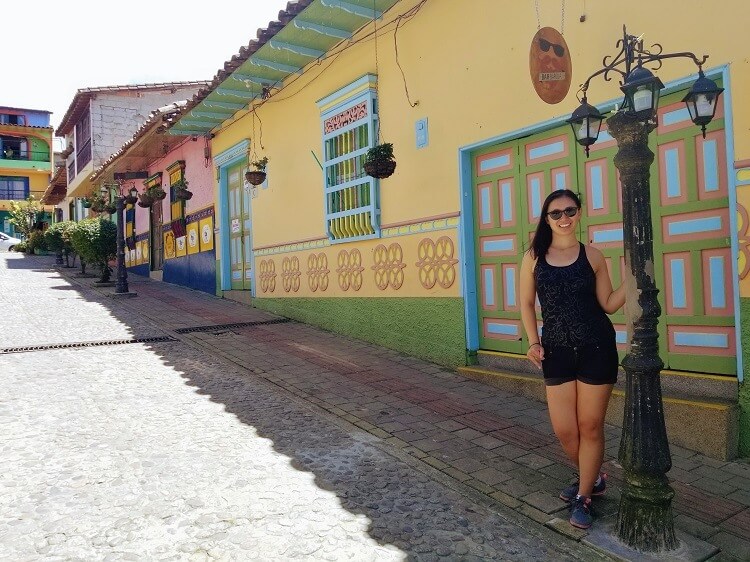
Day 6: From Medellin to Cartagena
After a long and active day trip to Guatape, take it easy on your last day in Medellin.
Explore the neighborhoods, check out the street art, and consider visiting Casa de la Memoria, the part-museum, part-memorial to those lost during the city’s most dangerous years.
Watch the sunset at the wall
Then make your way to the coastal city of Cartagena, aka Cartagena de Indias.
For a leisurely introduction to the city, hit up the Cartagena Old Town wall for some gorgeous Caribbean sunsets. Pick up a six-pack from the grocery store or buy drinks from the many vendors there, and just enjoy the Caribbean breeze.
Days 7-8: Time for a Caribbean vacation
A quick note about Cartagena’s weather: it is hot, hot, hot. Oh, and humid, too.
I’m talking 89 degrees Fahrenheit, feels like 105 — at 8 in the morning. So while you probably needed at least a light jacket for Bogota’s foggy, mountainous chill, you’ll be wanting to wear as little as possible by the time you get to Cartagena.
Get your inner Instagram model on
Start your first full day in this port city by exploring the beauty of Cartagena’s Old Town.
And maybe even get a little glam for the ‘gram with Cartagena’s fabulous doors and facades.
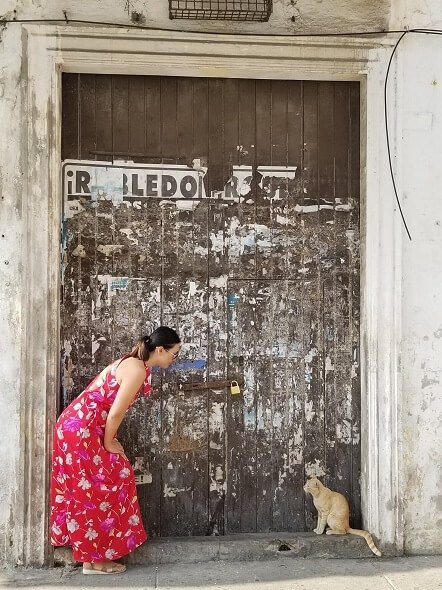
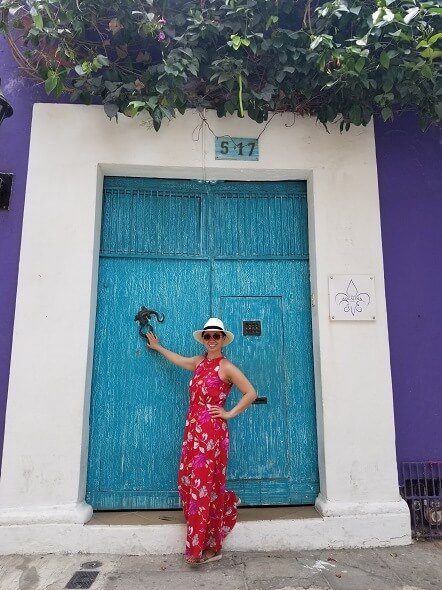
Cartagena, a different side of Colombian history
Then get a little more serious with the last walking tour (I promise!) of the trip.
Unlike Bogota and Medellin, Cartagena showcases a different side of Colombian history. A port city bombarded by pirates, a hub of the Caribbean slave trade, a city that celebrates three different independence days.
Join Free Tour Cartagena, and you’ll get to learn all about it.
Escape the heat at the “coolest” bookstore
Needing a break from the heat and humidity? Get some rest and a reprieve from the blazing Caribbean sun by heading to the coolest bookstore in town: Abaco Libros y Cafe.
This adorable brick-decorated bookshop is cool in so many ways. It’s so easy to pick up a good book and enjoy it along with AC and a drink.
Coffee, booze, coffee and booze? Up to you.
Salsa time!
After dinner, it’s salsa time! While Cali is known as the salsa capital, Cartagena’s not a bad spot either.
We went to Donde Fidel on the recommendation of a local. The spot is a bit small, but it is full of Colombians, local and from elsewhere in the country, enjoying great music, cold beer, and (watching people) salsa.
It was horrendously loud and way too bright, though. Great place for watching the pros dance, not great to try to pick up a few moves.
Two other recommended spots: Cafe Havana and Quiebra Canto. I hear those are better for actually hitting the dance floor.
Explore Getsemani’s art
Step outside of Cartagena’s walls for your second day there and explore the ever-so-cool, so-hipster-but-maybe-really-just-gentrifying neighborhood of Getsemani.
It’s got Cartagena’s best street art, adorable alleys, and a great people-watching spot in Plaza de la Trinidad.
Plus, it’s also the locale for many of Cartagena’s coolest hostels. Backpackers, onto Getsmani you go.

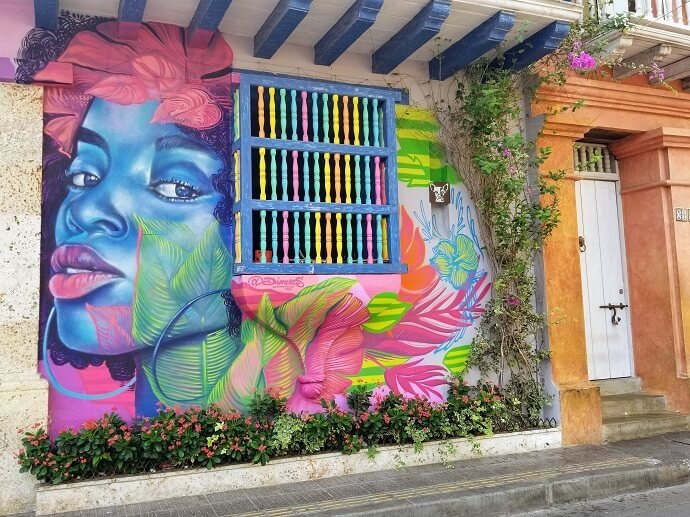
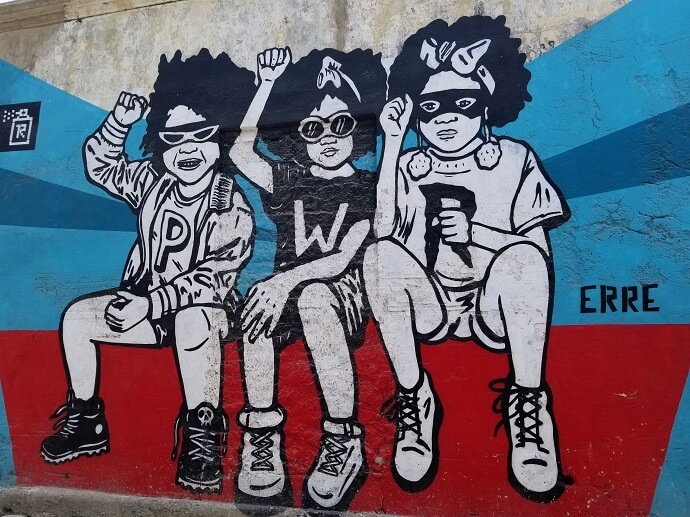
Adventures abound in Cartagena’s fort
If you have interest in military history or just want to see something a little different, consider checking out Castillo de San Felipe de Barajas. It’s the fort that helped protect Cartagena from the many pirates that attacked it over the centuries.
Tickets are $25,000 COP per person, a bit more than it was worth in my opinion. Then again, Cartagena had a city-wide blackout the day we visited the fort, so perhaps the cool respite we got in the fort’s tunnels were well worth it.
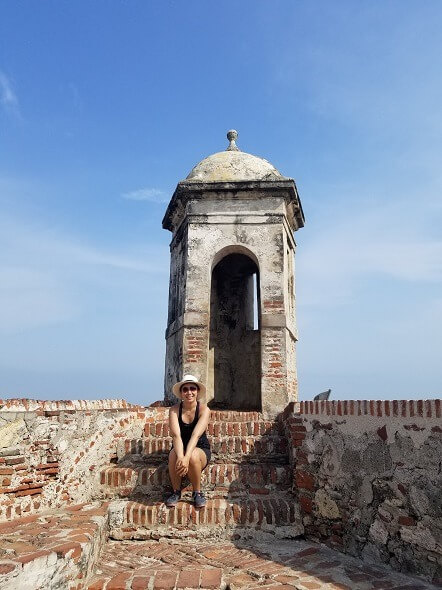
Take an evening stroll in an urban park
Squirrels, iguanas, sloths! Yep, you can see all those in the heart of Cartagena in Centennial Park.
It’s the perfect place to spend the dusk hours after a long hot day and before your nighttime plans.
Where to stay in Cartagena
Besides the hostels of Getsemani, Cartagena has tons of amazing hotels and hostels for all budgets.
I’d suggest staying at least part of your time in Old Town and the other part in Getsemani.
How to get around Cartagena
You walk. Seriously, it’s the best mode of transportation, especially when you’re in Cartagena Old Town, Getsemani, and other surrounding areas.
If the heat is a bit much for you for longer walks or you need non-walking options for another reason, taxis are also incredibly affordable in Cartagena.
There are also local buses, of course. We walked everywhere so we didn’t get a chance to take one, but they honestly looked like a hoot based on what we saw (and yes, I mean regular buses, not the chiva party buses.)
Days 9-10: A getaway from the getaway
And then it’s time for a getaway from the getaway. That is, head out to the Caribbean islands off of Cartagena’s coast.
You can stick to Isla Baru for the closest option, check out one of the many Rosario Islands, or even fly out to the island of San Andres.
Because we only had 10 full days in Colombia to fit in everything you’ve read, we stuck to the closest option: Isla Baru and Playa Blanca.
Hello, Playa Blanca
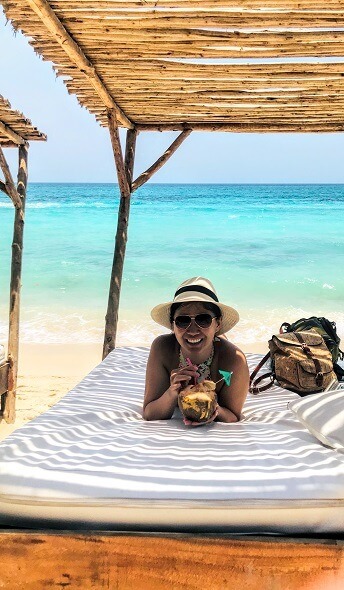
Because Playa Blanca is the closest island option from Cartagena, it can be very crowded, especially on weekends when locals also go to enjoy its beauty.
The farther you walk from the head of the beach, the more peaceful and less crowded it will be. Unfortunately, it does also get a bit rockier as you get deeper into Playa Blanca.
Your best bet? Go closer to the crowds when you want to be in the water, but stay somewhere farther away, and relax in a cabana somewhere in the middle. We enjoyed the cabana, drinks, and food at Hostel Restaurant Brenely.
Make sure to bring more cash than you think you need, though. There are no ATMs on the island, and most of the establishments do not accept anything except cash. Those cabanas, tropical drinks, and seafood dishes add up way faster than you think.
Pro tip: Should you find yourself a bit low on cash, go eat your meals at Los Corales. It’s located near the start of the beach and accepts credit cards for a 5% surcharge.
And then, just enjoy (and maybe remember to reapply your sunscreen as well) until you have to head back to Cartagena and then hasta luego to Colombia.
Where to stay in Playa Blanca
Waking up to the ocean breeze blowing in. Falling asleep to the sound of the waves. Seriously the best parts about staying overnight in Playa Blanca! We especially loved walking up and hanging out on our seaside balcony.
The accommodations on Playa Blanca truly are basic, but there are still some nicer ones that include breakfast, bucket showers, and indoor toilets in the price. Our private room at Nuestra Cabanita was on the lower end at $110,000 COP (~$34 USD).


If Playa Blanca’s offerings are too basic for you, consider staying elsewhere on Isla Baru where there are more resorts. I’ve heard fantastic things about Hotel Playa Manglares Isla Baru.
How to get to Playa Blanca
How to get around Playa Blanca would be a silly section to include, but I’m sure you’ll want to know how to get there.
There are tons of tour agencies in Cartagena offering transit to Playa Blanca (your lodging probably will as well). But if you’re looking to DIY it, Hostel Mamallena in Getsmani has basically corned the market on public transit. For $50,000 COP per person, you get round-trip tickets on an AC-equipped, direct shuttle to and from Playa Blanca.
If you have four people, you can also consider taking a taxi or speedboat there.
I hope this massive post on our 10-day Colombia itinerary has inspired you and will help you plan your trip. Pin it to share it!


[…] packing versatile items that can get squished without a problem. When it came to packing for our 10 days in Colombia, I had to do some extra planning to make it all work because, well, Colombia’s geographical […]
Such a detailed post. Thank you for all of the information and especially details of how safe it is.
Hi! How did you travel between each city?
Hi Chrishana,
We flew within Colombia via Avianca (except for our day trip from Medellin to Guatape, which we did by bus). You can take buses as well, but we did not have the time for that.
Let me know if you have any other questions!
Rowena
[…] learned “travel” Spanish from Duolingo in the past to prepare for trips to Cuba, Peru, Colombia, and […]
[…] said, yours truly got on a local bus in Colombia and stammered through Duolingo Spanish and still somehow got from the suburbs into the city center. […]
Thanks for a great post. I have been concerned about visiting some parts of Colombia but I feel relieved after reading your post. I’m planning to visit South America for 6 months and now may stay longer in Colombia than first planned.
I have been dying to visit Columbia! The colourful streets and doors are just stunning. I will keep this itinerary in mind for my future travels!
This is so interesting! and love the photos!!